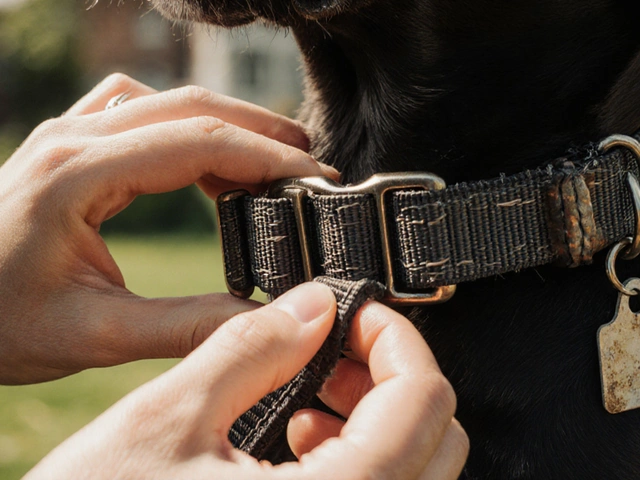Say the name Cesar Millan and you’ll get a big reaction from dog lovers. For some, he’s the master of calm assertive energy. For others, he’s controversial. But the question that stirs up clouds around his style is simple: does Cesar Millan use training collars?
The Truth About Cesar Millan’s Tools: Which Collars He Actually Uses
Watch a Cesar Millan episode, and there’s a good shot you’ll spot a leash and collar combination that looks different from your average flat collar. While he’s not one to use bulky, gadget-filled training contraptions, Millan has never hidden his preference for certain collars. Yes, he’s used slip leads, and yes, he has also worked with prong collars in some cases.
Why these collars? For Millan, it isn’t really about the collar. He says it’s about communication and safety, especially when handling dogs that are reactive or downright aggressive. The slip lead is one of his trademark tools. It’s simple: a piece of rope or fabric that tightens if the dog pulls, loosens if the dog relaxes. Not fancy, but effective when timing and technique are spot on. You’ll rarely see him recommending electronic (shock) collars; in fact, he’s openly critical of remote-controlled punishment tools. But when dealing with truly dangerous cases—a Rottweiler that lunges, a shepherd that bites—he has occasionally reached for other options, like the prong collar. According to a behind-the-scenes video from his "Dog Psychology Center," Millan stresses that the human behind the leash matters more than the collar itself.
He’s also honest that collars alone don’t fix anything. In fact, in interviews (like a memorable chat on "Larry King Live"), he broke down how a tool in unskilled hands can actually cause more harm than good. Slip leads and prong collars need skillful use—correct pressure, proper placement, and, most of all, calm energy. He claims the biggest mistake dog owners make isn’t which collar, but how they let their feelings run wild. Nervous owner? Nervous dog.
There’s another layer here: Millan often uses training collars for management, never as punishment. If a dog is about to bolt at another dog, the collar helps redirect; it’s not about corrections for minor snafus. His whole philosophy revolves around owning the moment, not dominating the animal. So, while the collars show up, they’re a piece of a bigger puzzle.
Why Training Collars Spark So Much Debate—And What the Science Says
This is where things get spicy. A training collar (from slip leads to prong collars) can stir up more arguments among dog people than any other gear. For decades, pet stores lined their shelves with choke chains and prongs. But the conversation shifted over the last twenty years with a huge surge in positive reinforcement training. So what makes dog pros so divided?
The main argument from critics: collars like prongs or slip leads can hurt dogs if used incorrectly. They point to a body of studies, like a well-shared review in the Journal of Veterinary Behavior in 2017, showing that harsh corrections can lead to higher stress, fear, or even injury. Positive trainers say a treat pouch and a clicker get results just as fast—without risk.
But let’s not ignore real life. In a 2023 survey of American dog trainers, nearly 35% admitted to using some version of a training collar at least occasionally—most often, they’re working with dogs too reactive or strong for treats alone. Millan himself has said that for some rescue dogs who could end up euthanized for biting, a tool might make the difference between rehab and a shelter death sentence.
The science isn’t black and white. While some studies find correlations between aversive tools and stress, others found that experienced handlers using collars were able to teach leash manners without negative long-term effects. The context—the dog’s temperament, the handler’s timing, and the training plan—matters just as much as the tool itself.
Let's look at the types of collars commonly used in training, including by Millan:
- Slip Lead: Simple, allows for quick corrections, tightens if pulled. Used mostly for quick training sessions.
- Martingale Collar: Similar to slip, but with a limit so it can’t choke the dog.
- Prong Collar: Metal links distribute pressure evenly. Highly controversial—can cause pain if misused, but fans say it can be safer than a slip for powerful dogs if properly fitted.
- Flat Collar: Standard, mainly for ID tags, not training.
- Head Halter: Works by steering the dog’s nose. Less common with Millan but popular elsewhere.
| Collar Type | Pros | Cons | Common Use |
|---|---|---|---|
| Slip Lead | Simple, quick control | Can choke if misused | Walks, training reactive dogs |
| Prong Collar | Even pressure, can stop pulling | Controversial, risk of pain | Serious behavior cases |
| Martingale | Limits how much it tightens | Still possible to misuse | Everyday walks, sighthounds |
| Flat Collar | Comfortable, standard | Dogs can slip out if they pull | ID tag, casual use |
| Head Halter | Good control, less physical effort | Some dogs hate the feel | Training, powerful pullers |

Cesar Millan’s Philosophy: More Than Just a Collar
So, why doesn’t Cesar Millan just hand out treat bags and cheer for every "sit" and "stay"? Here’s where his approach stands out. Millan is big on energy, leadership, and the relationship between dog and owner. He calls it “calm, assertive energy,” and says dogs crave direction as much as affection.
This doesn’t mean he’s shouting commands or yanking on leashes. If you pay close attention, Millan spends a ton of time talking about walking posture, breathing, and the owner’s body language. He’s walked into hundreds of chaotic homes with leash-aggressive German Shepherds and fence-jumping Jack Russells, and usually, the first fix is the human, not the collar.
He’s stated that tools like the slip lead are "for communication, not domination." In video breakdowns of his famous cases, Millan will pause to show where the leash pressure is light, the collar sits high behind the ears, and the dog is watching the handler for cues—not fighting the restraint. In live events and clinics, he’s been known to place a slip lead on a rowdy dog, calmly redirecting rather than yanking, and then quickly switching to praise when the dog relaxes.
This is something many viewers miss when they see clips online. The collar isn’t some magic wand; it’s a telephone line. If both parties are shouting, nothing gets through. Millan is explicit that when he’s forced to use a stronger tool—say, for a big dog with a bite history—it comes with even greater responsibility: constant monitoring, clear timing, and fast transition to a looser, more positive tool. He’s also quick to switch away from any collar if he sees stress, aggravation, or injury signs.
His philosophy boils down to balance: yes, be kind, but don’t skip rules and structure. That resonates for a lot of people with big, stubborn, or rescued dogs that didn’t grow up in a positive reinforcement bubble. He’s won over some trainers who’d sworn off “old school” methods after seeing how quickly some rescues can turn around when structure and communication line up.
What does this actually look like? Sometimes, he’ll walk with a dog ten times in a row, calmly adjusting the leash, then immediately reward the first step of soft, relaxed walking. He’s just as likely to have owners swap out gear for something less intense once they feel in sync with their pup.
If You Want to Try Cesar Millan’s Collar Methods—Here’s What to Know
This is the “don’t try this at home”—unless you do your homework part. Training collars, whether a slip lead or a prong, are not plug-and-play. They need timing, patience, and a solid understanding of dog body language. If you fumble, jerk, or correct at the wrong moment, you risk confusing or hurting your dog, or even building fear of the collar itself.
Tips for those thinking about using training collars, Cesar-style:
- Get educated. That means watching reputable trainers, in-person or on video. Preferably from more than just Millan—many modern trainers demonstrate humane handling of slip leads and martingales.
- Start with the least invasive tool possible. For a lot of dogs, a simple flat collar or harness works. Only upgrade to slip leads or prongs if other approaches flop and only under supervision.
- Fit matters. Prong collars, for instance, need to sit high and snug, not dangling or pressing on the trachea. A loose prong is the fastest way to hurt a dog.
- Use short, light tugs—never constant pressure or yanking. Millan’s trademark “pop and release” style isn’t about punishment but about interrupting a bad behavior in the split second it happens.
- Body language counts. Stand tall, breathe slowly, don’t let fear or anger flow down the leash.
- Transition out. The goal is never to keep a strong collar on forever. Millan often has owners move to lighter gear as soon as possible, rewarding every good step along the way.
- Watch for stress. Signs like tucked tails, pinned ears, or constant yawning mean it’s time to step back and reassess your strategy.
- Don’t go it alone with complicated or aggressive cases, especially big-breed rescues with a bite history. Get a pro to walk you through the steps—or even handle the first sessions entirely.
- Combine with positive rewards. Even in Millan’s world, affection, toys, and treats all have their place once control is established.
One last reminder: not every tool is for every dog or every owner. Some dogs are just too sensitive, and some humans struggle with timing. The aim (and Millan would agree) is always to get to a walk where nobody needs corrections—just communication and trust.
So does Cesar Millan use training collars? Definitely. But it’s how, when, and why he does that really sets him apart from the average dog owner at the park. If you want to try his methods, it’s worth taking the time to understand the "why" behind each step. You might just end up with the calm, happy dog you’ve always wanted—and a better understanding of what happened when that famous slip lead made its debut on TV.







